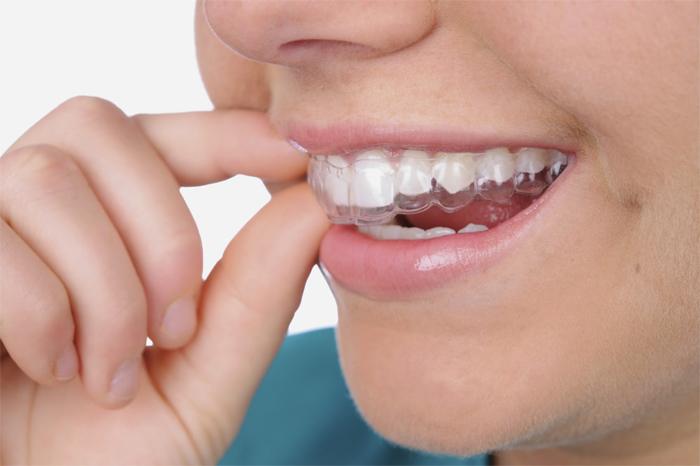Table of Contents
It isn’t very common for dentistry to overlap with semantics, but recent advancements in orthodontic treatments have made a little exposition necessary. So in the interest of getting things straightened out, let’s clarify some terms that have seen some confusing usage: invisible aligners and clear braces.

What Are Clear Braces?
Clear braces (sometimes called transparent braces or invisible braces) are similar to traditional braces, except the brackets are a transparent ceramic rather than stainless steel, and the wire and ligatures are usually clear as well. This makes the braces fairly inconspicuous unless you’re very close to the wearer.
The ceramic blends in naturally to the color of the teeth they’re attached to, and they’re stain resistant, adding to their appeal. Unlike traditional braces, the ceramic brackets never need to be adjusted, and their high durability means they’re difficult to damage.
They’ve been used for decades to correct teeth without making the patient’s mouth look like a cheese grater, and have been seen on the pearly whites of people as famous as Tom Cruise. They tend to be more expensive than traditional metal braces, but for those concerned about picking up the nickname “metal mouth,” they can be a welcome alternative.
The History of Clear Braces
Clear braces have been around for a while, but even so, many people have never heard of them. For some, it may be shocking just to learn that there is such thing as transparent ceramic. In reality, clear braces have been on the market since 1987, and the technology has been around even longer than that.
It all started with a company called Ceradyne. Ceradyne was making advanced ceramics for applications in military, aerospace, and electronics. They even worked with NASA. At one point, they tried to develop a ceramic that could be used in infrared radomes (i.e. protecting radar equipment while still being transparent to the radio waves they’re transmitting). What they developed was translucent polycrystalline alumina (TPA).
Then, in 1986 3M approached Ceradyne looking for a material that was simultaneously 1) strong enough to be used in orthodontics and 2) transparent to reduce its visual profile. Ceradyne said something along the lines of “You know, we do have this one product,” (we’re paraphrasing), and the two companies starting putting TPA to work.
The very next year the first clear braces, “Transcend Brackets,” were introduced, and production has been escalating ever since.
What Are Invisible Aligners?
Invisible aligners (sometimes called clear aligners, or mislabeled as invisible braces) have more in common visually with retainers than braces. In practice, their function mimics traditional metal brackets. They’re a clear plastic mold that’s worn over the teeth to slowly adjust them the way traditional braces would, while still offering the low cost and removability of a retainer.
They work like this. A mold is taken of the patient’s teeth (either with a take-home kit or by a professional), and that mold is used to create a 3D model of their mouth. A treatment plan is then developed, where the teeth will be adjusted in two-week increments until the desired structure is reached.
Then the plastic aligners are fabricated and shipped to the patient. Each set is worn for 20+ hours a day for two weeks, after which the patient switches to the next set. Treatment usually requires about 15 aligners over seven or eight months, but can take 13 months or more, with some cases necessitating a retainer for maintenance post-treatment.
The History of Invisible Aligners
Unlike clear braces, the history of invisible aligners is much shorter. Back in 1997, two Stanford University graduates took the concept of retainers, which are used to maintain the arrangement of teeth, and turned them into something that could improve the arrangement of teeth. They began using 3D modeling to map out dental structure, and then formed treatment plans from those models. The models were then used to create the aligners.
The concept spent three years in development, with the inventors tweaking the procedure to ensure effectiveness before releasing the product after the turn of the millennium. Today, clear aligners have treated millions of patients, making it possible for many to improve their smile without enduring the embarrassment of traditional braces.
What’s the Difference?
While both clear braces and invisible aligners are designed to fill the same function, there are some notable differences between the two. Those differences will likely have a dramatic impact on your decision to use one or the other.
- Aligners are more discreet than clear braces.
- Aligners are removable, making them ideal for adults who prefer to avoid the hassles of eating and cleaning teeth with braces in place.
- Clear braces are ideal for children, who are likely to remove aligners or underuse them.
- Clear braces are harsh on other cosmetic dentistry, like dental veneers.
- Clear braces are more expensive than traditional braces, while aligners are much cheaper than either.
For most adults, aligners are often the preferred choice due to the low cost, the low visibility, and low disruption of daily life. You don’t have to go into the dentist every month for an adjustment, to start the treatment or to have them removed. Then again, severe enough dental cases may require the level of adjustment that only true braces (either clear or traditional) can provide.
Either way, remember that the treatment is temporary, and eventually the pain and discomfort will all be over, and you’ll have the smile you want.





